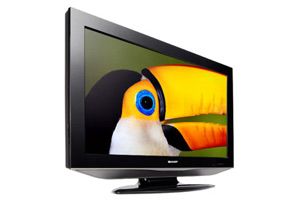TOKYO: Sony Corp, struggling to return its television business to profit, may pass Samsung Electronics Co this year as the top seller of flat-screen TVs in India, the fastest-growing major market, researcher DisplaySearch said.
 In a shift from an earlier strategy that focused on India’s wealthiest shoppers, Sony has gained market share by offering cheaper models and expanding its distribution network, Hisakazu Torii, a Tokyo-based analyst at DisplaySearch, said in an interview. The maker of Bravia TVs last year ranked third in India behind Samsung and LG Electronics Inc, he said.
In a shift from an earlier strategy that focused on India’s wealthiest shoppers, Sony has gained market share by offering cheaper models and expanding its distribution network, Hisakazu Torii, a Tokyo-based analyst at DisplaySearch, said in an interview. The maker of Bravia TVs last year ranked third in India behind Samsung and LG Electronics Inc, he said.
“We’re finally starting to see the fruits of Sony’s efforts to strengthen its brand image and its sales network,” Torii said. “There’s a real possibility they could take the top share for the year.”
Sony’s push in India is part of a larger move by Japanese companies including Toshiba Corp, who are following South Korean rivals in expanding into emerging markets. Still, a weak consumer recovery in the US and Europe, Sony’s traditional strongholds, may prevent Chief Executive Officer Howard Stringer from ending a six-year losing streak at the TV business.
‘Late to the party’
Japan’s largest exporter of consumer electronics accounted for 23 per cent of all flat-panel TVs sold in India during the first nine months of this year while Samsung and LG lagged behind at about 22 per cent, DisplaySearch’s Torii said. Last year, Samsung led with 29.3 per cent, followed by LG’s 23.1 per cent and Sony’s 22.9 per cent.
“The bottom line is: they might be late to the party, but Sony finally understands where they want to compete,” said Atul Goyal, a senior analyst at CLSA Asia-Pacific Markets in Singapore. “It was all Samsung and LG for the last 10 years, so for Sony to come up the way they have is impressive.”
Samsung won’t implement “low-price strategies” in emerging markets, James Chung, a company spokesman, said in an interview. “Previously, we focused on the US and European markets, but emerging markets such as India and South America are becoming more and more important.”
‘Harsh competition’
India and other emerging markets are the reason Sony has been able to keep its target of selling 25 million TVs this year, or 60 per cent more than last fiscal year, Vice President Hiroshi Yoshioka said. The final tally may fall short by “a little bit,” he said.
Selling more sets by itself isn’t enough to make the business profitable. Falling prices amid “harsh competition” this holiday season may mean that Sony’s TV operations lose money for a seventh consecutive year, Chief Financial Officer Masaru Kato said in October.
While flat-panel models only made up 22 per cent of the estimated 15.3 million TVs sold in India this year, the number of such sets is likely to double next year as Indian consumers replace their bulkier glass-tube models, according to Austin, Texas-based DisplaySearch. India is likely to become the world’s third-largest TV market next year, according to the researcher.
Emerging markets
Earlier this month, India’s finance ministry raised its economic growth forecast for the current year to 9.1 per cent, citing higher consumer demand in rural areas. At $1.3 trillion, India is the world’s second-fastest growing major economy.
Other Japanese manufacturers are also trying to make inroads in developing markets. Toshiba this month is introducing its own line of lower-priced models to double TV sales in Southeast Asia. The Tokyo-based company said last month it’s counting on growth in Asia next year to help offset an anticipated plunge in the domestic market after the expiration of government subsidies designed to boost consumer spending.
When Sony started selling flat-panel TVs in India in 2005, it targeted wealthier consumers who could afford a 40-inch Bravia that cost more than 200,000 yen ($2,400), said Yuki Shima, a Tokyo-based spokeswoman at Sony. The company focused on customers with annual salaries greater than $10,000 and is now reaching out to consumers who make as little as $4,000 a year while expanding into more cities, Shima said.
This year, Sony expanded its lineup to include smaller models such as 22-inch sets priced at about 34,000 yen. Replacing LED backlights with fluorescent bulbs in some sets helped Sony lower prices and also costs, Shima said. The company aims to double TV sales in India, she said, declining to comment on market share.
“If this is just a defensive move and they’re just going into these markets because the home market has collapsed, it won’t work,” said Chang Sea Jin, author of “Sony Vs. Samsung,” a 2008 book that chronicled how the South Korean company built an empire by focusing on developing economies. “It takes sustained investment.”


